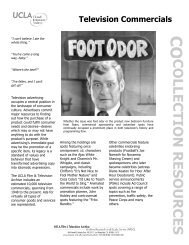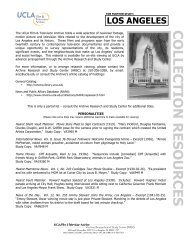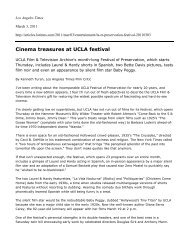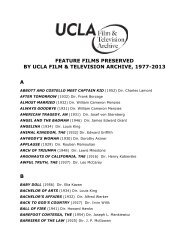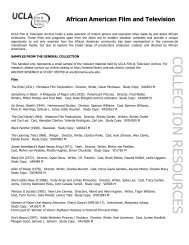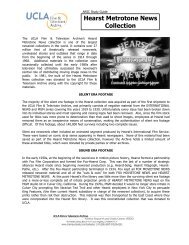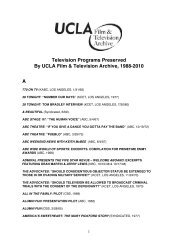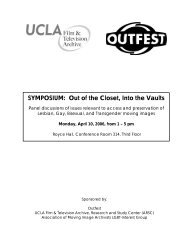reD sHoes restoreD - UCLA Film & Television Archive
reD sHoes restoreD - UCLA Film & Television Archive
reD sHoes restoreD - UCLA Film & Television Archive
- No tags were found...
You also want an ePaper? Increase the reach of your titles
YUMPU automatically turns print PDFs into web optimized ePapers that Google loves.
“Why do you want to dance?”“Why do you want to live?”Over the years, I’ve thought a lot about that exchange from The Red Shoes. It expresses so much about the burningneed for art, and I identified with that feeling the very first time I saw the picture with my father. I was so young then.It put me in contact with something in myself, a driving emotion I saw in the characters up there on the screen, and inthe color, the rhythm, the sense of beauty—in the filmmaking.The opening scene, for instance. Two worried men, dressed in black, pacing in a corridor. Behind them, two doors.We start to hear a clamor from the other side. One of them signals that it’s time to open those doors, and when they do aherd of students bursts through and lunges up the stairs, grabbing for mezzanine seats to a ballet performance. They’redriven by that hunger, that passion, for art. To see it, to feel it, to be inspired by it and maybe to become artists themselves.That passion drives every single, extraordinary moment of The Red Shoes, and it’s what makes the film’s gloriousTechnicolor images so forceful and moving, now restored to their full, shimmering beauty. The characters and theirworld are brought to life with the aching beauty they themselves long to create. The vivid reds and deep blues, thevibrant yellows and rich blacks, the lustrous fleshtones of the close-ups, some of them ecstatic and some agonizing,or both at once…so many moments, so many conflicting emotions, such a swirl of color and light and sound, allburned into my mind from that very first viewing, the first of many.The Red Shoes was the tenth collaboration between Michael Powell and Emeric Pressburger, and the seventh officialproduction they made under the banner of their own company, The Archers. Powell and Pressburger—two great artistsworking side by side, sharing credit, in a unique and unprecedented creative partnership. As was the case on all theirpictures, they worked with a team of extraordinary collaborators: the great Jack Cardiff, their cinematographer;Hein Heckroth, their production designer; Brian Easdale, their composer; the legendary Léonide Massine, who lenthis presence to the film in the role of Ljubov, and created and danced the part of the Shoemaker in the glorious centralballet sequence; and the remarkable cast, including Anton Walbrook, Moira Shearer, Marius Goring, Ludmilla Tchérina,Albert Basserman, and Robert Helpmann, who was also the film’s choreographer; together, they created somethingenduring and enthralling. This is how important art is, they seemed to be saying from the first shot to the last—it’s soimportant that it’s worth living for, and dying for.I’d like to thank Bob Gitt and his team at <strong>UCLA</strong> for their painstaking work, the Hollywood Foreign Press Associationfor their generous funding, and the Louis B. Mayer Foundation for their support. Once you see this restoration ofThe Red Shoes, you’ll want to thank them too.martin scorseseFounder and Chair, The <strong>Film</strong> FoundationTop to bottom: B&W separation master positiveof the blue record showing mold damage in B&W;recombined Eastman color image showing red,blue and green mold damage; 4K digital restorationoutput to film.
Dancing to the music of timeThe Red Shoes RestoredSeen in full-scale projection, The Red Shoes is not only one of cinema’s greatsensuous experiences, but a profound meditation on the power and the price ofall-consuming spectacle. Beyond the intensity of its performances and thebeauty of its images, it is this reflexive quality, shared with other masterpieces ofthe 1940s, that makes it a true classic, capable of being endlessly re-interpretedand rediscovered.The Red Shoes was indeed born from a determination to throw caution to thewinds. “You go too far”, the distinguished art director Alfred Junge warnedMichael Powell, whereupon Powell dropped him to take a chance on the painterHein Heckroth, who would triumphantly unify the film’s backstage and on-stageelements. So too with the all-important music and dance elements. Powelland his partner Emeric Pressburger rejected a score by their establishedcomposer in favor of one by the young Brian Easdale, taking the same risk thatthe impresario Lermontov does with Julian Craster in the film’s story.Pressburger had written the first version of the script while under contractto Alexander Korda in 1939. Intended as a vehicle for Korda’s future wifeMerle Oberon, it was assumed that a real ballerina would double in thedance sequences. But when Powell and Pressburger, now sharing theircredits as The Archers, returned to the subject in 1947, Powell insisted thatthe role of Vicky must be entirely performed by a dancer and that a realballet must be created. So the rising young ballerina Moira Shearer becamethe star of Lermontov’s ambitious new production and of the film.In Hans Christian Andersen’s savage, moralistic fairy tale, the red shoes that agirl covets lead to her destruction as they dance her to death. In The Archers’film, the girl lives a more complex version of the story both on stage and inlife, when she joins an international ballet company and The Red Shoesbrings her fame and love, but also intolerable pressure to submit to theimpresario’s will in order to live her dream.What was revolutionary in 1948 was to create and show a continuous 15 minuteballet that takes us from the stage world into the subjective heart of Vicky’sdesires and conflicts. Easdale’s music, Heckroth’s surreal design, Jack Cardiff’spainterly use of Technicolor, and the inspired partnership of leading dancersHelpmann and Massine with Shearer, all combined to make it a landmark infilm as ‘total art’, and an immediate inspiration to contemporary filmmakerssuch as Vincente Minnelli and Stanley Donen. Standing midway between MayaDeren’s avant-garde psychodrama Meshes of the Afternoon (1943) and JeanCocteau’s poetic allegory Orphée (1950), it is now belatedly recognized as amajor achievement of Britain’s Neo-Romantic movement, usually identifiedwith painting and poetry, but here triumphantly carried into cinema.The model for the Lermontov company was clearly the Ballets Russescompanies that continued to tour after Diaghilev’s death in 1929, and theirstyle and allure is wonderfully evoked in both the film’s Covent Garden andMonte Carlo scenes. But as some early reviewers realised, the world thatAnton Walbrook’s Lermontov rules with a mixture of steel and seductioncould be any collective artistic enterprise. It’s about the joy of teamwork,adrenaline and discipline, and ultimately sacrifice. And as much about makingcinema as about ballet, with the Alexander Korda that Powell and Pressburgerknew so well serving more as a model for Lermontov than Diaghilev.It was also a reminder of the wider world for audiences weary after WorldWar II. Foreign travel and the Mediterranean setting for the young lovers’romance and the ballet company’s relaxation may have seemed remote tomost in 1948, but The Archers had always aimed ahead and often abroad—their motto was ‘better to miss Naples than hit Margate’. Images of Parisand the Riviera were intended to transport viewers beyond their limitedhorizons, to strike a blow for art and beauty amid post-war austerity. And itis this sense of a creative world and its passion that communicated withaudiences, especially in America, making The Red Shoes an inspiration forgenerations of would-be dancers, and filmmakers. Martin Scorsese and Briande Palma are just two of many who testify to being profoundly influenced byseeing the film in childhood, and its traces can still be seen in theirs and others’work. What impressed Scorsese so powerfully was the vivid Technicolorchoreography of color and movement, the bold play of point-of-view aswe move from being spectators to sharing the protagonists’ emotions, and thecommanding figure of Anton Walbrook as Lermontov—inspiring, demonic andseductive, in one of cinema’s great character creations.Now, thanks to Martin Scorsese, Thelma Schoonmaker Powell and The <strong>Film</strong>Foundation, Powell and Pressburger’s original vision has been restored sothat it can continue to challenge and inspire future generations.Ian ChristieWriter and <strong>Film</strong> Historian
about the Restoration<strong>UCLA</strong> <strong>Film</strong> & <strong>Television</strong> <strong>Archive</strong> and The <strong>Film</strong> Foundation have been working on the current restoration of The RedShoes from the fall of 2006 through the spring of 2009. Earlier, in the 1980s, the film had been optically copied fromflammable nitrate to safety acetate film by the BFI and Rank <strong>Film</strong> Distributors, using the best celluloid technology thenavailable. In undertaking this new restoration, our goal has been to build upon these past efforts, utilizing moderntechniques to produce digital and film preservation elements of the highest possible quality.We were provided access to over two hundred reels of 35mm nitrate and acetate materials, including vintage Technicolordye transfer prints, nitrate and acetate protection master positive copies, original soundtrack elements, and—mostimportant of all—the still extant three-strip Technicolor camera negatives. For quality reasons, we chose these originalnegatives as our starting point even though they were afflicted with a daunting number of problems: sixty-five per centof the film had bad color fringing caused by differential shrinkage and sometimes by mis-adjustment of the cameraduring shooting; 176 shots contained color flickering, mottling and “breathing” because of uneven development andchemical staining; seventy sequences contained harsh optical effects with excessive contrast; and throughout there werethousands of visible red, blue and green specks caused by embedded dirt and scratches. Worst of all, mold had attackedevery reel and begun to eat away the emulsion, leaving behind thousands of visible tiny cracks and fissures.Extensive digital restoration was the only practical solution. Warner Bros. Motion Picture Imaging and Prasad CorporationLtd. were chosen to undertake the immense task of digitally scanning 579,000 individual frames directly from the three-stripcamera negatives, re-registering the colors, removing visible specks and scratches, mitigating color breathing, solvingcontrast issues, performing shot-to-shot color correction, and finally recording all 134 minutes back to 35mm Eastmancolor internegative stock. To obtain uniformly high quality results, 4K resolution was employed at every stage of the digitalpicture restoration work. Digital techniques were also employed by Audio Mechanics to remove pops, thumps, crackles andexcessive background hiss from the film’s original variable density optical soundtrack.In the restoration process, the entire film was turned into ones and zeros, repaired, and then converted back into a motionpicture again. In order to achieve a proper film look, we compared the new digital images with those in an originalTechnicolor dye transfer print and in a new Eastman color test print struck by Cinetech Laboratories directly from the YCMcamera negatives. Careful adjustments were made in the finalized digital version to combine the best qualities of moderncolor film (greater image sharpness, more sparkle in highlights) with the most pleasing attributes of vintage Technicolordye transfer prints (bold colors, deep blacks, gentle contrast with a pleasing range of tones in actors’ faces). We have evenretained the familiar Technicolor changeover cues, with their distinctive magenta circle surrounded by a bright green ring.The end result is a restoration that combines the best of the past with our digital present.Photos depict severe mold damage to theoriginal negatives.Robert GittPreservation Officer, <strong>UCLA</strong> <strong>Film</strong> & <strong>Television</strong> <strong>Archive</strong>
The <strong>Film</strong> FoundationThe <strong>Film</strong> Foundation (www.film-foundation.org) is a nonprofit organization established in 1990 by Martin Scorsese. Thefoundation is dedicated to protecting and preserving motion picture history, and provides substantial annual support forpreservation and restoration projects at the leading film archives. Since its inception, the foundation has been instrumentalin raising awareness of the urgent need to preserve films and has helped to save more than 525 motion pictures. JoiningScorsese on the board are: Woody Allen, Paul Thomas Anderson, Wes Anderson, Francis Ford Coppola, Clint Eastwood,Curtis Hanson, Peter Jackson, Ang Lee, George Lucas, Alexander Payne, Robert Redford and Steven Spielberg. The <strong>Film</strong>Foundation is aligned with the Directors Guild of America whose President and Secretary-Treasurer serve on thefoundation’s board.<strong>UCLA</strong> <strong>Film</strong> & <strong>Television</strong> <strong>Archive</strong>The <strong>UCLA</strong> <strong>Film</strong> & <strong>Television</strong> <strong>Archive</strong> is renowned for its pioneering efforts to rescue, preserve and showcase moving image media, and is dedicatedto ensuring that the collective visual memory of our time is explored and enjoyed for generations to come. The <strong>Archive</strong> is a world leader inthe restoration of film, and important feature projects include Stagecoach (1939, John Ford), His Girl Friday (1940, Howard Hawks), Macbeth(1948, Orson Welles) and Killer of Sheep (1977, Charles Burnett). The <strong>Archive</strong> has also restored historical newsreels and hundreds of short subjects.Many of the <strong>Archive</strong>’s restorations screen at prestigious events around the globe and are released commercially on DVD.BFIThe BFI is the UK’s agency for film culture, aiming to provide people with access to the broadest choice of films, wherever they liveand however they want to access them. The BFI does this through preserving and curating the UK’s film heritage, generating newknowledge and content through an exciting and accessible cultural program (screenings, events, DVDs, festivals, theatrical distribution, publications,education) and reaching new audiences by inspiring and motivating people to seek out film culture. The BFI is proud to have contributed to therestoration of The Red Shoes with elements preserved by the BFI National <strong>Archive</strong>.
Warner Bros. Motion Picture ImagingWarner Bros. Motion Picture Imaging (MPI) operates one of the entertainment industry’s foremost state-of-the-art digitalpost production and restoration facilities, providing services such as digital intermediate, scanning, color correction, dirtand scratch removal and film recording. A leader in the field of film preservation and restoration, MPI has developed aunique and patented process to digitally restore classics from the vast Warner Bros. Studios film and television library as well as those of thirdpartyclients including such titles as The Godfather (1972, Francis Ford Coppola), Gone with the Wind (1939, Victor Fleming), The Wizard of Oz(1939, Victor Fleming), North by Northwest (1959, Alfred Hitchcock) and The Rocky Horror Picture Show (1975, Jim Sharman). Located on theWarner Bros. Studio lot in Burbank, California, MPI’s facility has received safety certification to store and work with nitrate film stock.Prasad Corporation Ltd.Prasad Corporation Ltd., a member of the 50 year old Prasad Group, is a pioneer in film post production servicesoperating the largest network of film labs and digital post facilities in India. Additionally, Prasad offers digital restorationof film, video and audio using the latest in equipment and technology. Prasad has digitally restored films from around the world includingseveral Academy Award ® winning motion pictures. Working with Warner Bros. Motion Picture Imaging, a team of more than 400 highly experienceddigital restoration experts at Prasad’s facilities in India worked tirelessly on The Red Shoes to bring this classic masterpiece back to its fullTechnicolor glory.



